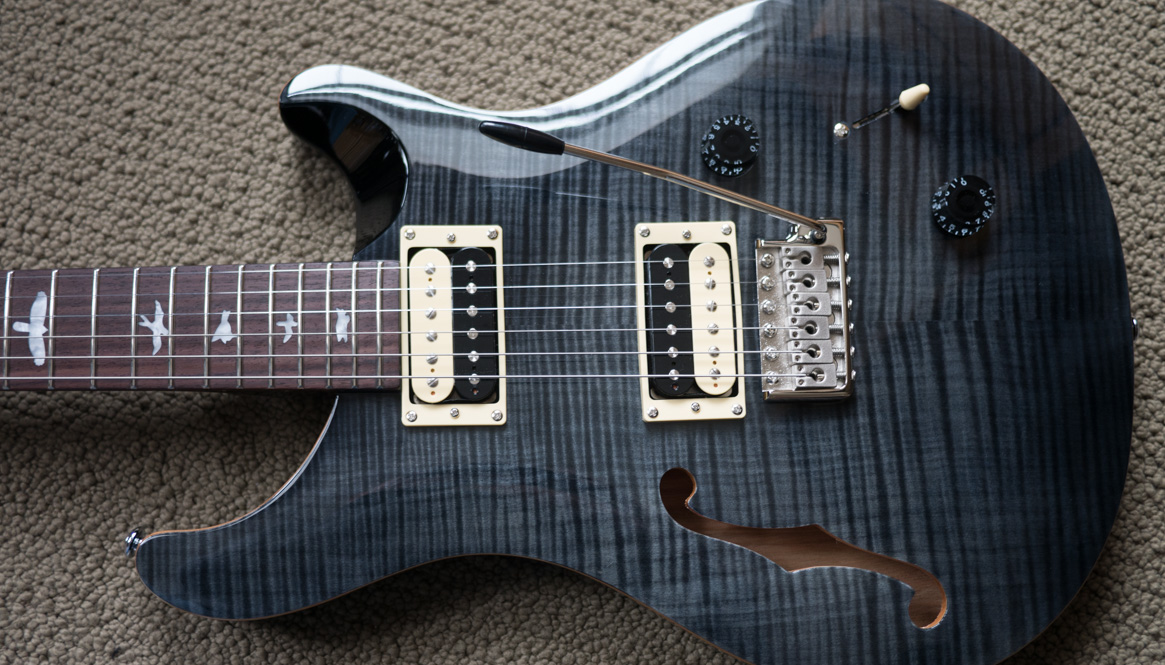PRS SE Custom 22 Trem Experiments
My SG has been transitioning into a project guitar, so I’ve been wanting an alternative to use as my gigging guitar. After having been spoiled by the lightweight SG, my Les Pauls just aren’t appealing for extended gigs and rehearsals.
While I usually play hardtail guitars, I continue to be intrigued by the flexibility of having a trem on the guitar. My very first electric guitar was an Ibanez 540S Saber with Floyd Rose. But honestly, I kinda hated the Floyd Rose – I was never a dive-bomber, and I always dreaded changing strings on the thing. Tuning nightmare!
On the other hand, the Bigsby on my Epiphone Riviera was smooth and lovely, but has a rather narrow bend range. I’ve sold both those guitars and now have no guitars with a vibrato bridge.

 Having never worked with a Strat-style trem, I thought it might be worth a shot.
Having never worked with a Strat-style trem, I thought it might be worth a shot.
I’ve always been intrigued by PRS guitars, but the price is traditionally out of reach. However, the PRS SE line, made in Korea, is quite affordable and reportedly great quality. So, I decided to give the PRS SE Custom 22 Semi-Hollow a try.
Sweetwater made the purchase easy, letting me pick my exact guitar. It weighed in at around 7 pounds – a bit heavier than the SG, but nowhere near the 9+ pound Les Pauls.
It’s a beautiful guitar, and the workmanship is very nice. The back of the headstock says it was built by World Instrument Co, Ltd in Korea – the same company that builds guitars for Gretsch, Line 6, Schecter, and others.
The frets are level and polished, the finish is clean, and the setup was reasonably good. The flamed veneer and bird inlays are a bit blingy, but it’s all good.
The headstock has the classic PRS signature, instead of the giant ugly SE on previous year SE models. The bridge is the PRS molded tremolo bridge.
The guitar feels good in the hand, and the 85/15 humbuckers sound nice.
A floating tremolo bridge like this can bend both up and down. It works great for songs like Stray Cat Strut and Wicked Game where I need some big vibrato and bends.
Unfortunately, I discovered fairly quickly that I just couldn’t get used to the dynamic nature of tuning when bending, with a bridge suspended on springs. By “dynamic nature of tuning”, I mean that some notes sound out of tune when playing certain riffs. For example, in a riff where you bend up a whole step on the B string and then add a minor third above by fretting the E string over the bend – the note played on the E string sounds a bit flat due to the pull of the bent string. I stopped in at a Guitar Center and played a few high-end American strats, and pricier PRS models, and while they all do this to some degree, I felt that this particular PRS SE was just worse.
As an experiment, I decided to try to block the tremolo. There are a few ways to do that- the first approach prevents the bridge from bending up, and only allows bending down. This supposedly improves tuning stability and sustain. You accomplish this by inserting a block of wood or similar spacer into the space between the bridge tremolo block and the body cavity towards the neck, and then tighten up the springs so they clamp the spacer in place. Here’s how:
First I removed the center spring. Then, for a spacer, I found that 3 quarters were about the right thickness, so I taped them together.
Then, I inserted this spacer between the tremolo block and the wood edge of the body cavity, tightened the springs a few turns to clamp the spacer in place, and then replaced the center spring.
I guess it helped a bit, but I still wasn’t satisfied.
Other options for blocking the tremolo are to place the spacer between the tremolo block and the tail of the guitar, or to just tighten the springs all the way down to make the tremolo very stiff. You can also add spacers on both sides of the tremolo block. In all of these cases, you’re effectively trying to turn your trem into a hardtail.
In any case, I couldn’t find a configuration that felt great to me here. I’m not sure why…
Another issue with a guitar that has a bunch of springs in the back is that they reverberate like a spring reverb tank. You can lay a thick felt pad under the springs to dampen their vibration if desired.
All this may or may not be your cup of tea. I’m fairly sure it’s not mine. Apparently, Clapton preferred the sound of a Strat with blocked trem compared to a hardtail Strat – I’d like to know more about what he prefers about the sound of that configuration. But my feeling is that if I’m going to go to all this trouble to prevent the trem from working, then I might as well just get a hardtail guitar!
So, in the end, as beautiful as this guitar was, I decided to return it and pursue a new lightweight hardtail guitar instead.














